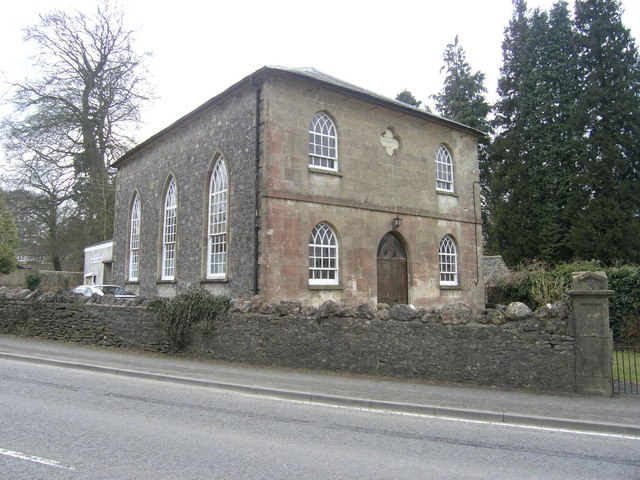|
Ashwick
Ashwick is a village in the Mendip district of Somerset, England, about three miles north of Shepton Mallet and seven miles east from Wells. It has also been a civil parish since 1826. The parish had a population of 1,352 according to the 2011 census, and apart from Ashwick village also includes Gurney Slade and Oakhill. History The area around Ashwick has evidence of occupation since the Iron Age, being in close proximity to Maesbury Castle. In Roman Britain, Fosse Way was constructed, which passes to the east of the parish. Although Oakhill is the larger village today, Ashwick is the older settlement, dating back to Anglo-Saxon times. It appears in the Domesday book as a settlement called Escewiche, which translates as 'the hamlet or farmstead by the ash trees'. The parish of Ashwick was part of the Hundred of Kilmersdon. The village is the site of Ashwick Court, a country house dating from the late 17th century and Grade II* listed. Anthony Newley's short-lived 1960 ATV ... [...More Info...] [...Related Items...] OR: [Wikipedia] [Google] [Baidu] |
Ashwick Court
Ashwick Court is Grade II* listed house on Heckley Lane northwest of Ashwick, in Mendip District, Mendip district, eastern Somerset, England, adjacent to the Church of St James, Ashwick, Church of St James. It is a country house, dating from the late 17th century and became a listed building on 2 June 1961. Alterations were added to the property in the 18th and mid-19th century. Building Parts of Ashwick Court date from the 17th century, but the building was extensively remodelled during the 18th century, including being given a new frontage. Two wings were added in the 20th century, the west wing in 1928 and the east in 1996. The main building is constructed of rendered rubble stone, with quoins in unrendered Bath stone ashlar. The two-story house has a near square floorplan, with a south entrance. The entrance bay and above is unrendered, with a 19th-century arched stone porch. Above the porch is a plaque made of stone showing the Strachey coat of arms and motto. The rear of t ... [...More Info...] [...Related Items...] OR: [Wikipedia] [Google] [Baidu] |
Church Of St James, Ashwick
The Church of St James in Ashwick, Somerset, England, is a church dating from 1881. It is a Grade I listed building, adjacent to Ashwick Court. It also houses a tower that dates back from 1450. The Victorian era, Victorian Gothic architecture, gothic building was erected between 1876 and 1881 by Browne and Gill of Bath, Somerset, Bath. However, the church tower dates back to 1463. The earliest record of a church on the site is 1413, when Nicholas Bubwith, Bishop Bubwith dedicated a churchyard at Ashwick and authorised burials to take place there, but it is not known when the church was first built. The church was originally a chapel of ease connected to the vicarage at Kilmersdon, near Radstock. It remained so until the formation of Ashwick parish. The benefice of Oakhill was added in 1923 and Binegar was added in 1969, since when one rector has overseen all three villages. At the west end of the aisles in the Church of St James two memorial tablets can be seen. These are dedica ... [...More Info...] [...Related Items...] OR: [Wikipedia] [Google] [Baidu] |
Oakhill
Oakhill is a village in the Mendip district of Somerset, England, in Ashwick parish approximately north of Shepton Mallet. It lies between the A37 and the A367 (which is part of the ancient Fosse Way). Oakhill is today is mainly a commuter village of in size, and is notable for former activities which including brewing. The village contains a Church of England primary school and a surgery, as well as a public house, the Oakhill Inn. Little London is the name given to a cluster of houses at the western end of the village. It is sometimes referred to by tradespeople etc. as a settlement in itself for the purpose of location, because of the elongated character of the village. History A brewing industry led to the growth of the village, and as a result a parish church, All Saints, was built in 1861 to a design by J. L. Pearson to provide a place of worship for the inhabitants, who previously had belonged to the parishes of Ashwick or Shepton Mallet, the boundary between which ... [...More Info...] [...Related Items...] OR: [Wikipedia] [Google] [Baidu] |
Mendip District
Mendip is a local government district of Somerset in England. The district covers a largely rural area of with a population of approximately 112,500, ranging from the Wiltshire border in the east to part of the Somerset Levels in the west. The district takes its name from the Mendip Hills which lie in its northwest. The administrative centre of the district is Shepton Mallet but the largest town (three times larger than Shepton Mallet) is Frome. The district was formed on 1 April 1974 under the Local Government Act 1972, by a merger of the municipal boroughs of Glastonbury and Wells, along with Frome, Shepton Mallet, Street urban districts, and Frome Rural District, Shepton Mallet Rural District, Wells Rural District, part of Axbridge Rural District and part of Clutton Rural District. On 1 April 2023, the district will be abolished and replaced by a new unitary district for the area at present served by Somerset County Council. The new council will be known as Somerset C ... [...More Info...] [...Related Items...] OR: [Wikipedia] [Google] [Baidu] |
Kilmersdon (hundred)
The Hundred of Kilmersdon is one of the 40 historical Hundreds in the ceremonial county of Somerset, England, dating from before the Norman conquest during the Anglo-Saxon era although exact dates are unknown. Each hundred had a 'fyrd', which acted as the local defence force and a court which was responsible for the maintenance of the frankpledge system. They also formed a unit for the collection of taxes. The role of the hundred court was described in the Dooms (laws) of King Edgar. The name of the hundred was normally that of its meeting-place. The Hundred of Kilmersdon consisted of the ancient parishes of: Ashwick, Babington, Buckland-Denham, Hardington, Hemington, Holcombe, Kilmersdon, Radstock, Stratton-on-the-Fosse, and Writhlington. It covered an area of . The importance of the hundred courts declined from the seventeenth century. By the 19th century several different single-purpose subdivisions of counties, such as poor law unions, sanitary districts, and highway d ... [...More Info...] [...Related Items...] OR: [Wikipedia] [Google] [Baidu] |
Wells (UK Parliament Constituency)
Wells is a constituency represented in the House of Commons of the UK Parliament since 2015 by James Heappey of the Conservative Party. History The original two-member borough constituency was created in 1295, and abolished by the Reform Act 1867 with effect from the 1868 general election. Its revival saw a more comparable size of electorate across the country and across Somerset, with a large swathe of the county covered by this new seat, under the plans of the third Reform Act and the connected Redistribution of Seats Act 1885 which was enacted the following year. ;Political history The seat was largely Conservative-held during the 20th century and has never elected a Labour MP ever in its history. The only other political party to have been represented is the Liberal Democrats or their predecessor, the Liberal Party, who achieved a marginal victory in 2010, see marginal seat. ;Prominent frontbenchers Sir William Hayter was chief government whip of the Commons under t ... [...More Info...] [...Related Items...] OR: [Wikipedia] [Google] [Baidu] |
Maesbury Railway Cutting
Maesbury Railway Cutting () is a 2 hectare geological Site of Special Scientific Interest between East Horrington and Gurney Slade in Somerset, notified in 1995. It was part of the Somerset and Dorset Joint Railway. This is a Geological Conservation Review site because it exposes approximately 135 metres of strata representing the middle and upper Lower Limestone Shales and the basal Black Rock Limestone. Both formations are of early Carboniferous ( Courceyan) age. It lies close to the Iron Age hill fort Maesbury Castle Maesbury Castle is an Iron Age hill fort within the parish of Croscombe on the Mendip Hills, just north of Shepton Mallet, Somerset, England. It has been listed as a Scheduled Ancient Monument. The name is derived from ''maes'', meaning ''fiel .... Sources English Nature citation sheet for the site(accessed 10 August 2006) External links English Nature website(SSSI information) {{SSSIs Somerset geological Sites of Special Scientific Interest in Som ... [...More Info...] [...Related Items...] OR: [Wikipedia] [Google] [Baidu] |
Somerset
( en, All The People of Somerset) , locator_map = , coordinates = , region = South West England , established_date = Ancient , established_by = , preceded_by = , origin = , lord_lieutenant_office =Lord Lieutenant of Somerset , lord_lieutenant_name = Mohammed Saddiq , high_sheriff_office =High Sheriff of Somerset , high_sheriff_name = Mrs Mary-Clare Rodwell (2020–21) , area_total_km2 = 4171 , area_total_rank = 7th , ethnicity = 98.5% White , county_council = , unitary_council = , government = , joint_committees = , admin_hq = Taunton , area_council_km2 = 3451 , area_council_rank = 10th , iso_code = GB-SOM , ons_code = 40 , gss_code = , nuts_code = UKK23 , districts_map = , districts_list = County council area: , MPs = * Rebecca Pow (C) * Wera Hobhouse ( LD) * Liam Fox (C) * David Warburton (C) * Marcus Fysh (C) * Ian Liddell-Grainger (C) * James Heappey (C) * Jacob Rees-Mogg (C) * John Penrose (C) , police = Avon and Somerset Police ... [...More Info...] [...Related Items...] OR: [Wikipedia] [Google] [Baidu] |
Cult Following
A cult following refers to a group of fans who are highly dedicated to some person, idea, object, movement, or work, often an artist, in particular a performing artist, or an artwork in some medium. The lattermost is often called a cult classic. A film, book, musical artist, television series, or video game, among other things, is said to have a cult following when it has a small but very passionate fanbase. A common component of cult followings is the emotional attachment the fans have to the object of the cult following, often identifying themselves and other fans as members of a community. Cult followings are also commonly associated with niche markets. Cult media are often associated with underground culture, and are considered too eccentric or anti-establishment to be appreciated by the general public or to be widely commercially successful. Many cult fans express their devotion with a level of irony when describing entertainment that falls under this realm, in that something ... [...More Info...] [...Related Items...] OR: [Wikipedia] [Google] [Baidu] |
Neighbourhood Watch (UK)
Neighbourhood Watch in the United Kingdom is the largest voluntary crime prevention movement covering England and Wales with upwards of 2.3 million household members. The charity brings neighbors together to create strong, friendly and active communities in which crime can be tackled. Neighbourhood Watch Network is the umbrella organization supported by the Home Office to support Neighbourhood Watch groups and individuals across England and Wales. Neighbourhood Watch groups work in partnership with the police, corporate companies with aligned values, voluntary organizations and individuals who want to improve their communities. Neighbourhood Watch aims to help people protect themselves and their properties and to reduce the fear of crime by means of improved home security, greater vigilance, accurate reporting of suspicious incidents and fostering a community spirit as well as tackling new forms of crime such as cybercrime. History In 1964, 28-year-old Kitty Genovese was stabb ... [...More Info...] [...Related Items...] OR: [Wikipedia] [Google] [Baidu] |
Parish Councils Of England
Parish councils are civil local authorities found in England which are the lowest tier of local government. They are elected corporate bodies, with variable tax raising powers, and they carry out beneficial public activities in geographical areas known as civil parishes. There are about 9,000 parish and town councils in England, and over 16 million people live in communities served by them. Parish councils may be known by different styles, they may resolve to call themselves a town council, village council, community council, neighbourhood council, or if the parish has city status, it may call itself a city council. However their powers and duties are the same whatever name they carry.Local Government and Public Involvement in Health Act 2007 Parish councils receive the majority of their funding by levying a precept upon the council tax paid by the residents of the parish (or parishes) covered by the council. In 2021-22 the amount raised by precept was £616 million. Other fundi ... [...More Info...] [...Related Items...] OR: [Wikipedia] [Google] [Baidu] |



